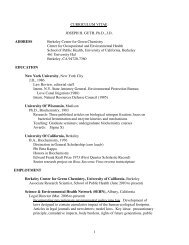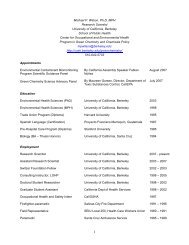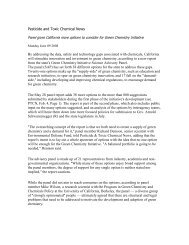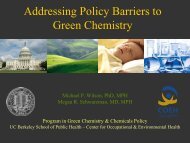Documentation of the nasal nitric oxide response to humming ...
Documentation of the nasal nitric oxide response to humming ...
Documentation of the nasal nitric oxide response to humming ...
Create successful ePaper yourself
Turn your PDF publications into a flip-book with our unique Google optimized e-Paper software.
European Journal <strong>of</strong> Clinical Investigation (2007) 37, 746–752<br />
DOI: 10.1111/j.1365-2362.2007.01845.x<br />
Blackwell Publishing Ltd<br />
<strong>Documentation</strong> <strong>of</strong> <strong>the</strong> <strong>nasal</strong> <strong>nitric</strong> <strong>oxide</strong> <strong>response</strong> <strong>to</strong><br />
<strong>humming</strong>: methods evaluation<br />
D. J. Shusterman, K. Jansen, E. M. Weaver and J. Q. Koenig<br />
University <strong>of</strong> Washing<strong>to</strong>n, USA<br />
Abstract<br />
Rationale Nitric <strong>oxide</strong> (NO) is present at higher concentrations in <strong>the</strong> <strong>nasal</strong> cavity than in<br />
<strong>the</strong> lower airway, and at even higher concentrations within <strong>the</strong> para<strong>nasal</strong> sinuses proper. When<br />
<strong>the</strong> para<strong>nasal</strong> sinus ostia are patent, acoustic activity produced by vocalization with closed<br />
lips (<strong>humming</strong>) promotes mixing <strong>of</strong> sinus with <strong>nasal</strong> gases, producing a fur<strong>the</strong>r increase in<br />
<strong>nasal</strong> NO. We wished <strong>to</strong> evaluate procedures for <strong>the</strong> documentation <strong>of</strong> <strong>the</strong> <strong>nasal</strong> NO <strong>response</strong><br />
<strong>to</strong> <strong>humming</strong>.<br />
Materials and methods We compared two ATS-recommended sampling methods: 1)<br />
active exhalation <strong>of</strong> lower airway gas (parallel technique) and 2) passive aspiration <strong>of</strong> <strong>nasal</strong><br />
gas with closed velopharynx (series technique). Variables controlled for included sampling<br />
rate, external resistance (parallel method), <strong>humming</strong> frequency, <strong>humming</strong> duration, and<br />
intertrial interval. Prior <strong>to</strong> upper airway sampling, exhaled lower airway NO was determined<br />
utilizing ATS-standardized technique.<br />
Results Ten volunteers (seven males and three females, aged 21–58) with no his<strong>to</strong>ry <strong>of</strong><br />
respira<strong>to</strong>ry allergies or sino-<strong>nasal</strong> disease were studied in a single session each. The parallel<br />
technique documented an increase in <strong>nasal</strong> NO during <strong>the</strong> <strong>humming</strong> manoeuvre in all<br />
subjects (mean ratio <strong>of</strong> <strong>humming</strong>-<strong>to</strong>-quiet NO, 4·2), whereas <strong>the</strong> series technique did so in<br />
eight <strong>of</strong> 10 subjects (mean ratio 2·1). Correcting for admixture from <strong>the</strong> lower airway, <strong>the</strong><br />
ratio <strong>of</strong> <strong>humming</strong>-<strong>to</strong>-quiet NO was greater with <strong>the</strong> parallel than series sampling technique<br />
(P < 0·05).<br />
Conclusions <strong>Documentation</strong> <strong>of</strong> <strong>the</strong> <strong>response</strong> <strong>of</strong> <strong>nasal</strong> NO <strong>to</strong> <strong>humming</strong> in subjects without<br />
sino-<strong>nasal</strong> disease was consistently achievable by parallel sampling using commercially<br />
available equipment. Specific operational procedures are proposed.<br />
Keywords Acoustic mixing, <strong>nasal</strong> cavity, <strong>nitric</strong> <strong>oxide</strong>, para<strong>nasal</strong> sinuses, sinusitis.<br />
Eur J Clin Invest 2007; 37 (9): 746–752<br />
Introduction<br />
Nitric <strong>oxide</strong> (NO) is a naturally occurring biogenic gas<br />
present at higher concentrations in <strong>the</strong> upper than in <strong>the</strong><br />
lower airway in humans. Although its physiological functions<br />
are incompletely unders<strong>to</strong>od, in <strong>the</strong> upper airway it<br />
Department <strong>of</strong> Medicine (D. J. Shusterman), Department <strong>of</strong><br />
Environmental and Occupational Health Sciences (D. J. Shusterman,<br />
K. Jansen, J. Q. Koenig), ‡ Department <strong>of</strong> O<strong>to</strong>laryngology/Head &<br />
Neck Surgery (E. M. Weaver), University <strong>of</strong> Washing<strong>to</strong>n, Seattle,<br />
WA, USA.<br />
Correspondence <strong>to</strong>: Dennis Shusterman, MD, MPH, Occupational<br />
and Environmental Medicine Program, 325 9th Ave., Box 359739,<br />
Seattle, WA 98104, USA. Tel.: +001 206-744-9398;<br />
fax: +001 206-744-9935; e-mail: dennis3@u.washing<strong>to</strong>n.edu<br />
Received 8 February 2007; accepted 4 May 2007<br />
is believed <strong>to</strong> have local antimicrobial activity, as well<br />
as influencing mucociliary function [1–3]. An apparent<br />
reservoir <strong>of</strong> NO in <strong>the</strong> upper airway is in <strong>the</strong> para<strong>nasal</strong><br />
sinuses, where concentrations can reach thousands <strong>of</strong><br />
parts-per-billion (several orders <strong>of</strong> magnitude higher than<br />
those normally found in <strong>the</strong> lower airway) [4,5]. The relative<br />
contribution <strong>to</strong> measured <strong>nasal</strong> NO by gas originating<br />
in <strong>the</strong> para<strong>nasal</strong> sinuses versus gas originating directly from<br />
<strong>the</strong> <strong>nasal</strong> mucosa is a subject <strong>of</strong> active investigation [6,7].<br />
Relatively recently, investiga<strong>to</strong>rs noted that <strong>the</strong> acoustic<br />
activity produced by vocalization with closed lips (<strong>humming</strong>)<br />
promotes mixing <strong>of</strong> sinus with <strong>nasal</strong> gases, thus producing<br />
a large ‘spike’ in NO concentration during real-time<br />
sampling [8,9]. This spike is dependent upon <strong>the</strong> patency<br />
<strong>of</strong> <strong>the</strong> para<strong>nasal</strong> sinus ostia, without which <strong>the</strong>re is no<br />
communication between <strong>the</strong> sinuses and <strong>nasal</strong> airway<br />
[10,11]. Thus, documentation <strong>of</strong> <strong>the</strong> <strong>nasal</strong> NO <strong>response</strong><br />
<strong>to</strong> <strong>humming</strong> holds promise for use as a surrogate index<br />
© 2007 The Authors. Journal Compilation © 2007 Blackwell Publishing Ltd
Nasal NO <strong>response</strong> <strong>to</strong> <strong>humming</strong> 747<br />
Table 1 Published study techniques for documenting <strong>the</strong> <strong>nasal</strong> NO <strong>response</strong> <strong>to</strong> <strong>humming</strong><br />
Reference Sampling technique Flow (L m –1 ) Pressure Time (s) Compensation<br />
8,9 Parallel 12 NS 5–10 <strong>nasal</strong> NO corr = <strong>nasal</strong> NO uncorr −FE NO<br />
13 Parallel NS NS NS NS<br />
15 Parallel Variable NS 10–20 None<br />
16 Series 0·7–1·2 NA 10 None<br />
17 Series 0·7 NA 10 None<br />
Nasal NO corr = <strong>nasal</strong> NO corrected; <strong>nasal</strong> NO uncorr = <strong>nasal</strong> NO (measured).<br />
FE NO = exhaled (lower airway) NO.<br />
NA = not applicable.<br />
NS = not specified.<br />
<strong>of</strong> para<strong>nasal</strong> sinus ostial patency, impairment <strong>of</strong> which<br />
is thought <strong>to</strong> be an important fac<strong>to</strong>r in <strong>the</strong> pathogenesis<br />
<strong>of</strong> sinusitis.<br />
The American Thoracic Society (ATS) has issued two<br />
consensus statements (1999, 2005) and one workshop<br />
(2006) on airway NO measurement, each mentioning<br />
<strong>nasal</strong> NO sampling [12–14]. The initial document advocated<br />
<strong>nasal</strong> NO sampling by passive aspiration across both <strong>nasal</strong><br />
cavities in series (series sampling), with velopalatine<br />
closure <strong>to</strong> exclude lower airway gases (which contain<br />
NO at concentrations exceeding ambient levels).<br />
Acceptable sampling rates ranged from 3 <strong>to</strong> 5 L min –1<br />
[12].<br />
Recognizing <strong>the</strong> impossibility <strong>of</strong> maintaining velopalatine<br />
closure during <strong>the</strong> <strong>humming</strong> manoeuvre, <strong>the</strong> ATS in 2005<br />
recommended ‘parallel’ sampling (active exhalation through<br />
both hemi-<strong>nasal</strong> cavities simultaneously) when <strong>the</strong> <strong>humming</strong><br />
manoeuvre was <strong>to</strong> be employed [13]. However, <strong>the</strong> parameters<br />
<strong>to</strong> be employed (flow rate, external flow resistance,<br />
frequency and duration <strong>of</strong> <strong>humming</strong>, correction for <strong>the</strong><br />
contribution <strong>of</strong> exhaled lower airway NO) were not specified,<br />
and actual techniques vary greatly among published<br />
studies [9,15–18]; Table 1.<br />
Our objective in this study was <strong>to</strong> systematize <strong>the</strong> various<br />
operational variables involved in documenting <strong>the</strong> <strong>humming</strong>induced<br />
spike in <strong>nasal</strong> NO in order <strong>to</strong> optimize <strong>the</strong> reproducibility<br />
<strong>of</strong> this diagnostic manoeuvre. The null hypo<strong>the</strong>sis<br />
was that series and parallel sampling techniques would be<br />
equally efficacious in documenting <strong>the</strong> <strong>nasal</strong> NO <strong>response</strong><br />
<strong>to</strong> <strong>humming</strong> in normal subjects without a prior his<strong>to</strong>ry <strong>of</strong><br />
allergic/sino-<strong>nasal</strong> disease.<br />
Materials and methods<br />
Subject recruitment<br />
Volunteer subjects were recruited from a university<br />
complex. Inclusion criteria included age 18–60 years and<br />
good general health. Exclusion criteria included active<br />
smoking, self-reported allergic rhinitis and/or sinusitis<br />
(lifetime his<strong>to</strong>ry), and cardiopulmonary diseases such as<br />
asthma or COPD (chronic obstructive pulmonary disease).<br />
Ten volunteers (seven males and three females, aged<br />
21–58 years) participated after reviewing and signing an<br />
informed consent document approved by <strong>the</strong> University <strong>of</strong><br />
Washing<strong>to</strong>n.<br />
Equipment<br />
Sampling was performed using a commercial chemiluminescent<br />
NO analyser (Sievers Model 280i, GE Analytical<br />
Instruments, Boulder, CO, USA), along with ei<strong>the</strong>r: 1) a<br />
Teflon sampling wand connected <strong>to</strong> a vacuum rotameter<br />
(Dwyer Instruments, Michigan City, IN, USA; ‘series<br />
method’) or 2) a commercially available flow-sensing<br />
apparatus designed for on-line NO sampling (Model 4000,<br />
TSI, Shoreview, MN, USA; ‘parallel method’). Alternate<br />
restric<strong>to</strong>rs for <strong>the</strong> flow sensor were obtained from <strong>the</strong> same<br />
manufacturer (TSI). Sampling occurred with continuous<br />
on-screen feedback (REB s<strong>of</strong>tware Version 3·21, GE<br />
Analytical Instruments, Boulder, CO, USA) on a lap<strong>to</strong>p<br />
computer. Sampling parameters utilized <strong>to</strong> determine<br />
(lower airway) fractional exhaled NO (FE NO ), <strong>nasal</strong> NO by<br />
<strong>the</strong> parallel technique, and <strong>nasal</strong> NO by <strong>the</strong> series technique<br />
are summarized in Table 2.<br />
Study procedures<br />
Two-point calibration (0 and 45 ppm) was performed on<br />
<strong>the</strong> NO analyser on each testing day. Subjects were asked<br />
<strong>to</strong> avoid eating for one hour prior <strong>to</strong> testing, caffeinecontaining<br />
beverages for two hours, and strenuous exercise<br />
for two hours. Note was made <strong>of</strong> <strong>the</strong> ambient (labora<strong>to</strong>ry)<br />
NO concentration (A NO ) on each testing day. Subjects<br />
were first coached on maintaining <strong>the</strong> target <strong>humming</strong><br />
frequency using an audio oscilla<strong>to</strong>r and microphone<br />
connected <strong>to</strong> <strong>the</strong> X and Y axes <strong>of</strong> an oscilloscope. Subjects<br />
practiced up <strong>to</strong> three times synchronizing <strong>the</strong>ir <strong>humming</strong><br />
with a 128 Hz sign wave. They were <strong>the</strong>n instructed <strong>to</strong><br />
avoid unnecessary verbalization and were given instructions<br />
regarding study procedures. Baseline (lower airway) FE NO<br />
was <strong>the</strong>n sampled by having subjects blow through a<br />
mouthpiece and bacteriological filter at 3 L m –1 per ATS<br />
standards [12,13].<br />
© 2007 The Authors. Journal Compilation © 2007 Blackwell Publishing Ltd, European Journal <strong>of</strong> Clinical Investigation, 37, 746–752
748 D. J. Shusterman et al.<br />
Table 2 Sampling parameters employed during lower airway and <strong>nasal</strong> NO sampling<br />
Technique (Lower airway) FE NO Nasal NO (parallel) Nasal NO (series)<br />
Interface Mouthpiece Mask Probe<br />
Flow rate 3 L min –1 5 L min –1 3 L min –1<br />
External resistance 33 340 Pa L –1 s –1 9450 Pa L –1 s –1 N/A<br />
Frequency <strong>of</strong> <strong>humming</strong>: N/A 128 Hz 128 Hz<br />
Duration <strong>of</strong> <strong>humming</strong>: N/A ≥ 10 s ≥ 10 s<br />
Inter-trial interval N/A 4 min 4 min<br />
Parallel sampling<br />
The restric<strong>to</strong>r on <strong>the</strong> sampling wand was changed from <strong>the</strong><br />
default for FE NO sampling (#2; 33 340 Pa L –1 s –1 at<br />
3 L min –1 ) <strong>to</strong> <strong>the</strong> next most patent (#3; 9450 Pa L –1 s –1 at<br />
5 L min –1 ), and a face mask (King System, Noblesville, IN,<br />
USA) was substituted for <strong>the</strong> mouthpiece. Subjects <strong>the</strong>n<br />
inhaled orally through <strong>the</strong> mask/wand (which is equipped<br />
with a NO-scrubbing filter on its intake), and exhaled<br />
<strong>nasal</strong>ly through <strong>the</strong> mask with on-screen visual feedback <strong>to</strong><br />
maintain a flow rate <strong>of</strong> approximately 5 L m –1 . Both flow<br />
and real-time <strong>nasal</strong> NO concentrations were recorded during<br />
this manoeuvre, which was repeated three times with quiet<br />
exhalation. Next, subjects inhaled orally through <strong>the</strong><br />
mask and wand and exhaled until <strong>the</strong> investiga<strong>to</strong>r signalled<br />
that a steady NO plateau had been reached, at which<br />
time subjects began <strong>humming</strong> at target frequency,<br />
maintaining <strong>the</strong> same flow rate. Humming duration was at<br />
least 10 s, and a 4 min recovery time (with <strong>the</strong> subject<br />
abstaining from verbalization) was allowed between each <strong>of</strong><br />
<strong>the</strong> 3 <strong>humming</strong> trials.<br />
Series sampling<br />
This technique utilizes a cus<strong>to</strong>m-fabricated Teflon sampling<br />
probe connected <strong>to</strong> a metered vacuum line operating at<br />
3 L min –1 , with <strong>the</strong> NO analyser drawing gas from a<br />
T-connec<strong>to</strong>r. Subjects were instructed <strong>to</strong> take a deep breath<br />
in through <strong>the</strong> mouth, achieve velopalatine closure by making<br />
<strong>the</strong> ‘k’ sound, <strong>the</strong>n <strong>to</strong> place <strong>the</strong> rounded end <strong>of</strong> <strong>the</strong> probe<br />
against <strong>the</strong> outside <strong>of</strong> one nostril and hold <strong>the</strong>ir breath<br />
for 15 s. During sampling air was drawn through <strong>the</strong> two<br />
hemi-<strong>nasal</strong> cavities in series, passing across <strong>the</strong> nasopharynx.<br />
Three such manoeuvres were repeated quietly. Next,<br />
subjects repeated <strong>the</strong> procedure, but were instructed <strong>to</strong> hum<br />
for at least 10 s once <strong>the</strong> investiga<strong>to</strong>r signalled that a steady<br />
<strong>nasal</strong> NO plateau had been reached. This manoeuvre was<br />
repeated twice more, with a 4 min interval between trials.<br />
Finally, subjects were asked <strong>to</strong> simulate <strong>the</strong>ir series <strong>humming</strong><br />
manoeuvre through a nosepiece which was connected<br />
<strong>to</strong> a pneumotachometer (Hans Rudolph; Kansas City, MO,<br />
USA) differential pressure transducer and signal conditioner<br />
(Validyne Engineering, Northridge, CA, USA); <strong>the</strong><br />
opposite nostril was occluded during this manoeuvre. An<br />
estimate <strong>of</strong> steady-state flow during <strong>the</strong> series <strong>humming</strong><br />
manoeuvre was made using a calibration curve generated<br />
using a precision flow meter (Cole-Parmer, Vernon Hills,<br />
IL, USA).<br />
Data analysis<br />
For each NO tracing, area-under-<strong>the</strong>-curve (AUC) and<br />
average NO concentration were estimated for a 10 s period<br />
using Image J s<strong>of</strong>tware version 1·36b (NIH, Be<strong>the</strong>sda, MD,<br />
USA). Data were analysed using JMP Version 6 s<strong>of</strong>tware<br />
(SAS Institute, Carey, NC, USA).<br />
Raw data were treated in <strong>the</strong> following manner<br />
<strong>to</strong> obtain corrected <strong>humming</strong>-<strong>to</strong>-quiet (H/Q)<br />
<strong>nasal</strong> NO ratios:<br />
For parallel sampling, lower airway FE NO concentrations<br />
were deducted from both quiet and <strong>humming</strong> <strong>nasal</strong> NO:<br />
Parallel H/Q corrected = [(PH – FE NO )/(PQ – FE NO )]*<br />
For series sampling, A NO (background NO concentration)<br />
was deducted from quiet <strong>nasal</strong> NO, whereas lower airway<br />
(FE NO ) concentrations were deducted from <strong>humming</strong> <strong>nasal</strong><br />
NO:<br />
Series H/Q corrected = [(SH – FE NO )/(SQ – A NO )]*<br />
*Where:<br />
A NO = Ambient (labora<strong>to</strong>ry) NO<br />
FE NO = Fractional exhaled (lower airway) NO<br />
PH = Parallel <strong>humming</strong> <strong>nasal</strong> NO<br />
PQ = Parallel quiet <strong>nasal</strong> NO<br />
SH = Series <strong>humming</strong> <strong>nasal</strong> NO<br />
SQ = Series quiet <strong>nasal</strong> NO<br />
Statistical analysis<br />
Data were checked for normality, and both <strong>the</strong> arithmetic<br />
and geometric mean values reported, and data logtransformed,<br />
when significant skew was detected. Group<br />
comparisons (parallel versus series sampling) were performed<br />
using ei<strong>the</strong>r analysis <strong>of</strong> variance or non-parametric<br />
tests (Wilcoxon rank-sum or Wilcoxon signed-rank), as<br />
appropriate.<br />
Results<br />
Crude data for <strong>the</strong> experiment appear in Table 3. The mean<br />
background concentration <strong>of</strong> NO in <strong>the</strong> labora<strong>to</strong>ry at <strong>the</strong><br />
© 2007 The Authors. Journal Compilation © 2007 Blackwell Publishing Ltd, European Journal <strong>of</strong> Clinical Investigation, 37, 746–752
© 2007 The Authors. Journal Compilation © 2007 Blackwell Publishing Ltd, European Journal <strong>of</strong> Clinical Investigation, 37, 746–752<br />
Table 3 Raw data from experiment<br />
Subject # Age Gender<br />
SQ<br />
(ppb)<br />
SQ_COV<br />
SH<br />
(ppb) SH_COV SH/SQ<br />
PQ<br />
(ppb)<br />
PQ_COV<br />
PH<br />
(ppb) PH_COV PH/PQ<br />
FE NO<br />
(ppb)<br />
Vhum<br />
(L min –1 )<br />
1 57 M 100 3% 356 11% 3·57 67 10% 205 4% 3·07 31·3 5·6 3·0<br />
2 58 F 86 6% 437 15% 5·09 62 2% 502 20% 8·06 15·4 3·8 10·5<br />
3 52 M 223 3% 395 9% 1·77 52 14% 208 12% 4·02 28·3 6·2 4·1<br />
4 35 M 283 5% 514 22% 1·82 211 5% 347 15% 1·65 48·8 4·2 18·0<br />
5 21 F 132 4% 300 12% 2·27 87 13% 182 8% 2·09 14·0 6·2 20·0<br />
6 38 F 115 0% 76 5% 0·67 71 9% 130 5% 1·8 28·3 7·1 24·0<br />
7 40 M 96 3% 203 36% 2·13 53 9% 125 10% 2·34 22·5 8·0 12·0<br />
8 49 M 122 18% 62 5% 0·51 29 16% 436 14% 15·2 27·5 4·5 4·2<br />
9 41 M 107·1 1% 136 12% 1·27 62 4% 95 1% 1·53 36·4 5·3 2·5<br />
10 57 M 140 5% 241 13% 1·72 109 2% 242 9% 2·22 62·9 4·5 7·0<br />
Key <strong>to</strong> abbreviations:<br />
A NO , Ambient NO. [background lab NO concentration]<br />
COV, Coefficient <strong>of</strong> variation. [SD/mean]<br />
FENO , Exhaled (lower airway) NO. [Per ATS sampling standard]<br />
PH, Parallel <strong>humming</strong>. [Nasal NO during...]<br />
PQ, Parallel quiet.<br />
SH, Series <strong>humming</strong>.<br />
SQ, Series quiet.<br />
Vhum, Airflow during <strong>humming</strong>. [pneumotachometer measurement]<br />
A NO<br />
(ppb)<br />
Nasal NO <strong>response</strong> <strong>to</strong> <strong>humming</strong> 749
750 D. J. Shusterman et al.<br />
Figure 1 Humming-induced ‘spike’ in<br />
<strong>nasal</strong> NO: Parallel sampling method. Arrows<br />
indicate beginning <strong>of</strong> <strong>humming</strong> manoeuvre.<br />
Smaller spikes reflect positive pressure<br />
transient at beginning <strong>of</strong> each sampling run.<br />
Inter-trial interval for <strong>humming</strong> manoeuvres<br />
(4 min) is obscured by intermittent data<br />
logging.<br />
Figure 2 Humming-induced ‘spike’ in<br />
<strong>nasal</strong> NO: Series sampling method.<br />
Arrows indicate beginning <strong>of</strong> <strong>humming</strong><br />
manoeuvre. Smaller spikes reflect negative<br />
pressure transient at beginning <strong>of</strong> each<br />
sampling run. Inter-trial interval for<br />
<strong>humming</strong> manoeuvres (4 min) is obscured<br />
by intermittent data logging.<br />
time <strong>of</strong> sampling was 10·5 (± 7·8 SD) ppb, and <strong>the</strong> mean<br />
exhaled lower airway concentration across subjects was 31·5<br />
(± 14·9 SD) ppb. Nasal NO measured under baseline<br />
(quiet) conditions was log-normally distributed, and significantly<br />
lower using <strong>the</strong> parallel technique – mean 80<br />
(± 51 SD) ppb/70 ppb geometric mean, than <strong>the</strong> series<br />
technique, mean 140 (± 63 SD) ppb/130 ppb geometric<br />
mean (P < 0·01 by Wilcoxon rank sums). For quiet sampling,<br />
<strong>the</strong> mean coefficient <strong>of</strong> variation across subjects (i.e. mean<br />
<strong>of</strong> individual SD/mean) was 8% for <strong>the</strong> parallel and 5% for<br />
<strong>the</strong> series technique.<br />
During <strong>humming</strong>, all 10 subjects showed an increase<br />
in uncorrected <strong>nasal</strong> NO using parallel sampling, whereas<br />
only eight <strong>of</strong> 10 showed an increase using series sampling.<br />
For series sampling, all estimates <strong>of</strong> Vhum (airflow during<br />
<strong>humming</strong>) exceeded <strong>the</strong> series sampling rate (3 L min –1 )<br />
justifying <strong>the</strong> use <strong>of</strong> exhaled FE NO , ra<strong>the</strong>r than ambient NO,<br />
as <strong>the</strong> compensa<strong>to</strong>ry deduction during series <strong>humming</strong><br />
manoeuvres. Representative tracings for <strong>the</strong> parallel and<br />
series techniques appear in Figs 1 and 2, respectively. In<br />
general, <strong>the</strong> shape <strong>of</strong> <strong>the</strong> <strong>humming</strong>-induced ‘spike’ was<br />
broader using <strong>the</strong> parallel technique.<br />
For each technique, <strong>the</strong> ratio <strong>of</strong> <strong>humming</strong>-<strong>to</strong>-quiet (H/Q)<br />
<strong>nasal</strong> NO was computed on both a crude and corrected<br />
basis (see above). The distributions <strong>of</strong> both <strong>of</strong> <strong>the</strong>se metrics<br />
differed significantly from normal, resulting in <strong>the</strong>ir log<br />
transformations. Scattergrams comparing individual values<br />
<strong>of</strong> <strong>the</strong> two log-transformed metrics appear in Fig. 3 (uncorrected<br />
H/Q) and Fig. 4 (corrected H/Q). With <strong>the</strong> exception<br />
<strong>of</strong> two cases in which <strong>nasal</strong> NO actually decreased during<br />
© 2007 The Authors. Journal Compilation © 2007 Blackwell Publishing Ltd, European Journal <strong>of</strong> Clinical Investigation, 37, 746–752
Nasal NO <strong>response</strong> <strong>to</strong> <strong>humming</strong> 751<br />
Figure 3 Scattergram <strong>of</strong> log 10 (<strong>humming</strong>/quiet <strong>nasal</strong> NO<br />
uncorrected): parallel versus series sampling methods. Note two<br />
cases in which <strong>the</strong> series method yielded (<strong>humming</strong>/quiet <strong>nasal</strong><br />
NO) < 1 (log value < 0).<br />
5 Paired analysis: Comparison <strong>of</strong> sampling methods. The<br />
ratio <strong>of</strong> (<strong>humming</strong>/quiet <strong>nasal</strong> NO corrected) was significantly<br />
greater with <strong>the</strong> parallel than <strong>the</strong> series method (P < 0·01 by<br />
Wilcoxon signed-rank).<br />
Discussion<br />
Figure<br />
Figure 4 Scattergram <strong>of</strong> log 10 (<strong>humming</strong>/quiet <strong>nasal</strong> NO<br />
corrected): parallel versus series sampling methods. Note three<br />
cases in which <strong>the</strong> series method yielded (<strong>humming</strong>/quiet <strong>nasal</strong><br />
NO corrected) < 1 (log value < 0).<br />
<strong>humming</strong> using <strong>the</strong> series technique (three cases when<br />
considering corrected <strong>nasal</strong> NO levels), <strong>the</strong> remaining values<br />
<strong>of</strong> <strong>the</strong> two metrics varied on a roughly proportional basis.<br />
The mean ratio <strong>of</strong> <strong>humming</strong>-<strong>to</strong>-quiet <strong>nasal</strong> NO on an<br />
uncorrected basis was 4·2 (geometric mean 3·1) for parallel<br />
sampling and 2·1 (geometric mean, 1·7) for series (P = 0·13<br />
by Wilcoxon rank-sums). The corresponding corrected<br />
values were mean 31·1 (geometric mean, 5·6) for parallel<br />
sampling and 2·0 (geometric mean, 1·4) for series. The<br />
distribution <strong>of</strong> <strong>the</strong>se latter values differed significantly<br />
(P < 0·05 by Wilcoxon rank-sums). Additionally, we performed<br />
a paired analysis, comparing parallel versus series<br />
H/Q corrected by subject [Fig. 5]. In all but two <strong>of</strong> <strong>the</strong> cases,<br />
parallel H/Q corrected was greater than series H/Q corrected<br />
(P < 0·01 by Wilcoxon signed-rank). In sum, <strong>the</strong><br />
magnitude <strong>of</strong> <strong>the</strong> <strong>humming</strong>-induced ‘spike’ in <strong>nasal</strong> NO<br />
was significantly greater, on average, using <strong>the</strong> parallel<br />
ra<strong>the</strong>r than <strong>the</strong> series sampling technique once correction<br />
was made for admixture <strong>of</strong> exhaled lower airway and/or<br />
ambient gases.<br />
Previous ATS recommendations have been <strong>to</strong> use <strong>the</strong> series<br />
sampling method for static <strong>nasal</strong> NO measurements, and<br />
<strong>the</strong> parallel method <strong>to</strong> document <strong>the</strong> <strong>nasal</strong> NO <strong>response</strong> <strong>to</strong><br />
<strong>humming</strong> [17,18]. However, recommended sampling<br />
parameters have been more completely specified for <strong>the</strong><br />
former than for <strong>the</strong> latter case, and adherence <strong>to</strong> recommendations<br />
has been inconsistent in <strong>the</strong> published literature.<br />
In our study, both parallel and series techniques demonstrated<br />
substantial <strong>humming</strong>-induced ‘spikes’ in <strong>nasal</strong> NO in <strong>the</strong><br />
majority <strong>of</strong> normal subjects, although in two cases <strong>the</strong> results<br />
were discordant, <strong>the</strong> parallel method only showing this finding.<br />
To our knowledge this is <strong>the</strong> first study <strong>to</strong> compare <strong>the</strong><br />
performance <strong>of</strong> <strong>the</strong>se two sampling techniques, particularly<br />
by performing tandem measures in <strong>the</strong> same subjects. A<br />
strength <strong>of</strong> this study, in addition <strong>to</strong> its overall design, was<br />
its relatively strict control over several hi<strong>the</strong>r<strong>to</strong> inconsistently<br />
addressed sampling parameters, including <strong>humming</strong> frequency<br />
and duration, flow resistance (in <strong>the</strong> case <strong>of</strong> parallel sampling),<br />
intertrial interval, and flow rates. For example, while<br />
Maniscalco et al. (2003) explored <strong>the</strong> effect <strong>of</strong> <strong>humming</strong><br />
frequency on NO flux from <strong>the</strong> sinuses (finding higher<br />
flux at 130 Hz than at ei<strong>the</strong>r 150 or 450 Hz), <strong>the</strong>y s<strong>to</strong>pped<br />
short <strong>of</strong> advocating a specific frequency standard. In our<br />
case we chose 128 Hz because it was a fundamental frequency<br />
that was easily reproduced in both men and women <strong>of</strong><br />
varying ages, and a 128 Hz calibration standard (tuning<br />
fork) is widely available as a medical examination <strong>to</strong>ol.<br />
Limitations <strong>of</strong> this study, on <strong>the</strong> o<strong>the</strong>r hand, include <strong>the</strong><br />
relatively small sample size, <strong>the</strong> fact that we classified subjects’<br />
respira<strong>to</strong>ry health based upon self-report, and by <strong>the</strong><br />
consistent order <strong>of</strong> testing (parallel before series sampling).<br />
Although this last fac<strong>to</strong>r brings up <strong>the</strong> possibility <strong>of</strong> a testing<br />
order effect, we did not see a systematic diminution in NO<br />
AUC with <strong>humming</strong> across trials (data not shown), arguing<br />
that <strong>the</strong> 4 min intertrial interval was sufficient <strong>to</strong> permit<br />
relatively complete replenishment <strong>of</strong> sinus NO concentrations.<br />
© 2007 The Authors. Journal Compilation © 2007 Blackwell Publishing Ltd, European Journal <strong>of</strong> Clinical Investigation, 37, 746–752
752 D. J. Shusterman et al.<br />
Finally, our sampling rate for lower airway gas (3 L min –1 )<br />
was matched <strong>to</strong> <strong>the</strong> series sampling rate ra<strong>the</strong>r than <strong>the</strong><br />
parallel sampling rate. This decision in part reflected <strong>the</strong><br />
fact that <strong>the</strong> REB s<strong>of</strong>tware’s variability sensing routine was<br />
contingent upon sampling at 3 L min –1 , which it considers<br />
‘ATS standard.’ Ultimately, <strong>the</strong> flow rate for documenting<br />
<strong>nasal</strong> NO and exhaled FE NO should be matched, more likely<br />
at 5 L min –1 than 3 L min –1 given <strong>the</strong> Vhum values obtained<br />
from our subjects (mean Vhum, 5·5 L min –1 ). Of note, <strong>the</strong><br />
parallel sampling rate cited by <strong>the</strong> Lundberg labora<strong>to</strong>ry<br />
(12 L min –1 [8,9]); would not have been sustainable by many<br />
<strong>of</strong> our subjects for a 10 second period <strong>of</strong> <strong>humming</strong>, particularly<br />
since <strong>humming</strong> was not initiated until quiet <strong>nasal</strong><br />
NO levels had stabilized at <strong>the</strong> beginning <strong>of</strong> each expira<strong>to</strong>ry run.<br />
Uncorrected, <strong>the</strong> ratio <strong>of</strong> <strong>humming</strong>-<strong>to</strong>-quiet <strong>nasal</strong> NO,<br />
measured as an average over 10 s <strong>of</strong> <strong>humming</strong>, tended <strong>to</strong><br />
be greater using <strong>the</strong> parallel than series methods (geometric<br />
mean, 3·1 vs. 1·7; P = 0·13 by Wilcoxon rank sums). Correcting<br />
for admixture <strong>of</strong> ambient air and/or exhaled lower<br />
airway gas, <strong>the</strong> ratio <strong>of</strong> <strong>humming</strong>-<strong>to</strong>-quiet <strong>nasal</strong> NO was<br />
significantly greater using <strong>the</strong> parallel method (geometric<br />
mean, 5·6 vs. 1·4; P < 0·05). Perhaps more important than<br />
any statistical comparison, however, was <strong>the</strong> consistency <strong>of</strong> <strong>the</strong><br />
‘spike’ finding with <strong>the</strong> parallel, but not series, method. We<br />
thus find ourselves in agreement with <strong>the</strong> ATS recommendation<br />
based upon our structured comparison <strong>of</strong> techniques.<br />
The anomalous finding <strong>of</strong> a reduction <strong>of</strong> <strong>nasal</strong> NO with<br />
<strong>humming</strong>, as documented in two cases using <strong>the</strong> series sampling<br />
method, begs explanation. Whereas <strong>the</strong> <strong>to</strong>tal flow rate<br />
with <strong>the</strong> series and parallel methods differed substantially<br />
(3 L min –1 vs. 5 L min –1 ), <strong>the</strong> average flow rate through<br />
each hemi-<strong>nasal</strong> cavity was more closely matched (3 L min –1<br />
vs. 2·5 L min –1 , assuming equal partitioning <strong>of</strong> flow with <strong>the</strong><br />
parallel method). At baseline (i.e. with quiet exhalation), <strong>the</strong><br />
series method yielded higher <strong>nasal</strong> NO concentrations than<br />
did <strong>the</strong> parallel method. This argues that <strong>the</strong> serial augmentation<br />
<strong>of</strong> NO in sampled gas across <strong>the</strong> two hemi-<strong>nasal</strong> cavities<br />
was important in achieving this result. Loss <strong>of</strong> sampling<br />
from <strong>the</strong> opposite hemi-<strong>nasal</strong> cavity during <strong>humming</strong> may<br />
have <strong>of</strong>fset any augmented contribution from <strong>the</strong> sinuses in<br />
<strong>the</strong>se two cases, despite <strong>the</strong> fact that exhaled lower airway<br />
NO concentrations exceeded ambient concentrations.<br />
Para<strong>nasal</strong> sinus ostial obstruction, whe<strong>the</strong>r from infection,<br />
allergy, or inhaled irritants, is thought <strong>to</strong> be a part <strong>of</strong> <strong>the</strong><br />
pathophyisiological chain resulting in <strong>the</strong> development <strong>of</strong><br />
sinusitis, an inflamma<strong>to</strong>ry upper airway condition with serious<br />
associated morbidity and costs [18–20]. Standardization <strong>of</strong><br />
<strong>the</strong> method for documenting <strong>the</strong> <strong>nasal</strong> NO <strong>response</strong> <strong>to</strong><br />
<strong>humming</strong> would help fur<strong>the</strong>r <strong>the</strong> use <strong>of</strong> this non-invasive<br />
technique as a surrogate for para<strong>nasal</strong> sinus ostial patency<br />
in both diagnostic and pathophysiological studies <strong>of</strong> sinusitis.<br />
References<br />
1 Lundberg JO. Airborne <strong>nitric</strong> <strong>oxide</strong>: inflamma<strong>to</strong>ry marker and<br />
aerocrine messenger in man. Acta Physiol Scand Suppl<br />
1996;633:1–27.<br />
2 Alberty J, August C, S<strong>to</strong>ll W, Rudack C. The effect <strong>of</strong><br />
endogenous <strong>nitric</strong> <strong>oxide</strong> on cholinergic ciliary stimulation <strong>of</strong><br />
human <strong>nasal</strong> mucosa. Laryngoscope 2004;114:1642–7.<br />
3 Runer T, Lindberg S. Ciliostimula<strong>to</strong>ry effects mediated by<br />
<strong>nitric</strong> <strong>oxide</strong>. Acta O<strong>to</strong>laryngol 1999;119:821–5.<br />
4 Lundberg JO, Farkas-Szallasi T, Weitzberg E, Rinder J,<br />
Lidholm J, Anggaard A et al. High <strong>nitric</strong> <strong>oxide</strong> production in<br />
human para<strong>nasal</strong> sinuses. Nat Med 1995;1:370–3.<br />
5 Andersson JA, Cervin A, Lindberg S, Uddman R, Cardell LO.<br />
The para<strong>nasal</strong> sinuses as reservoirs for <strong>nitric</strong> <strong>oxide</strong>. Acta<br />
O<strong>to</strong>laryngol 2002;122:861–5.<br />
6 Lundberg JO, Rinder J, Weitzberg E, Lundberg JM, Alving K.<br />
Nasally exhaled <strong>nitric</strong> <strong>oxide</strong> in humans originates mainly in <strong>the</strong><br />
para<strong>nasal</strong> sinuses. Acta Physiol Scand 1994;152:431–2.<br />
7 Haight JS, Djupesland PG, Qjan W, Chatkin JM, Furlott H,<br />
Irish J et al. Does <strong>nasal</strong> <strong>nitric</strong> <strong>oxide</strong> come from <strong>the</strong> sinuses?<br />
J O<strong>to</strong>laryngol 1999;28:197–204.<br />
8 Weitzberg E, Lundberg JO. Humming greatly increases <strong>nasal</strong><br />
<strong>nitric</strong> <strong>oxide</strong>. Am J Respir Crit Care Med 2002;166:144–5.<br />
9 Maniscalco M, Weitzberg E, Sundberg J, S<strong>of</strong>ia M, Lundberg<br />
JO. Assessment <strong>of</strong> <strong>nasal</strong> and sinus <strong>nitric</strong> <strong>oxide</strong> output using<br />
single-breath <strong>humming</strong> exhalations. Eur Respir J<br />
2003;22:323–9.<br />
10 Lundberg JO, Maniscalco M, S<strong>of</strong>ia M, Lundblad L, Weitzberg<br />
E. Humming, <strong>nitric</strong> <strong>oxide</strong>, and para<strong>nasal</strong> sinus obstruction.<br />
JAMA 2003;289:302–3.<br />
11 Maniscalco M, S<strong>of</strong>ia M, Weitzberg E, De Laurentiis G,<br />
Stanziola A, Rossillo V et al. Humming-induced release <strong>of</strong> <strong>nasal</strong><br />
<strong>nitric</strong> <strong>oxide</strong> for assessment <strong>of</strong> sinus obstruction in allergic<br />
rhinitis: pilot study. Eur J Clin Invest 2004;34:555–60.<br />
12 ATS (American Thoracic Society). Recommendations for<br />
standardized procedures for <strong>the</strong> on-line and <strong>of</strong>f-line<br />
measurement <strong>of</strong> exhaled lower respira<strong>to</strong>ry <strong>nitric</strong> <strong>oxide</strong> and <strong>nasal</strong><br />
<strong>nitric</strong> <strong>oxide</strong> in adults and children-1999. Am J Respir Crit Care<br />
Med 1999;160:2104–17.<br />
13 ATS (American Thoracic Society). ATS/ERS<br />
Recommendations for standardized procedures for <strong>the</strong> online<br />
and <strong>of</strong>fline measurement <strong>of</strong> exhaled lower respira<strong>to</strong>ry <strong>nitric</strong><br />
<strong>oxide</strong> and <strong>nasal</strong> <strong>nitric</strong> <strong>oxide</strong>, 2005. Am J Respir Crit Care Med<br />
2005;171:912–30.<br />
14 Silk<strong>of</strong>f PE, Erzurum SC, Lundberg JO, George SC, Marczin<br />
N, Hunt JF et al. ATS workshop proceedings: exhaled <strong>nitric</strong><br />
<strong>oxide</strong> and <strong>nitric</strong> <strong>oxide</strong> oxidative metabolism in exhaled breath<br />
condensate. Proc Am Thorac Soc 2006;3:131–45.<br />
15 Menzel L, Hess A, Bloch W, Michel O, Schuster KD, Gabler<br />
R et al. Temporal <strong>nitric</strong> <strong>oxide</strong> dynamics in <strong>the</strong> para<strong>nasal</strong> sinuses<br />
during <strong>humming</strong>. J Appl Physiol 2005;98:2064–71.<br />
16 Struben VM, Wieringa MH, Mantingh CJ, Bruinsma SM,<br />
de Jongste JC, Feenstra L. Silent and <strong>humming</strong> <strong>nasal</strong> NO<br />
measurements in adults aged 18–70 years. Eur J Clin Invest<br />
2005;35:653–7.<br />
17 Struben VM, Sewbalak WV, Wieringa MH, Mantingh CJ, van<br />
den Toorn LM, Bakker M et al. Nasal <strong>nitric</strong> <strong>oxide</strong> in cystic fibrosis<br />
with and without <strong>humming</strong>. Eur J Clin Invest 2007;37:140–4.<br />
18 Bhattacharyya N. The economic burden and symp<strong>to</strong>m<br />
manifestations <strong>of</strong> chronic rhinosinusitis. Am J Rhinol<br />
2003;17:27–32.<br />
19 Murphy MP, Fishman P, Short SO, Sullivan SD, Yueh B,<br />
Weymuller EA Jr. Health care utilization and cost among adults<br />
with chronic rhinosinusitis enrolled in a health maintenance<br />
organization. O<strong>to</strong>laryngol Head Neck Surg 2002;127:367–76.<br />
20 Ray NF, Baraniuk JN, Thamer M, Rinehart CS, Gergen PJ,<br />
Kaliner M et al. Healthcare expenditures for sinusitis in 1996:<br />
contributions <strong>of</strong> asthma, rhinitis and o<strong>the</strong>r airway disorders.<br />
J Allergy Clin Immunol 1999;103 (3 Part 1):408–14.<br />
© 2007 The Authors. Journal Compilation © 2007 Blackwell Publishing Ltd, European Journal <strong>of</strong> Clinical Investigation, 37, 746–752











